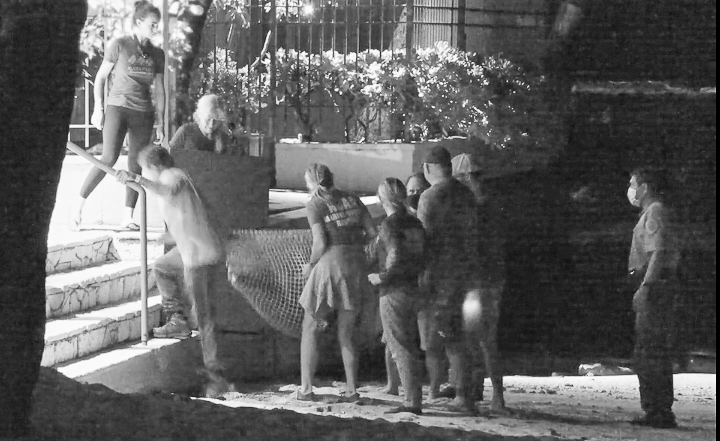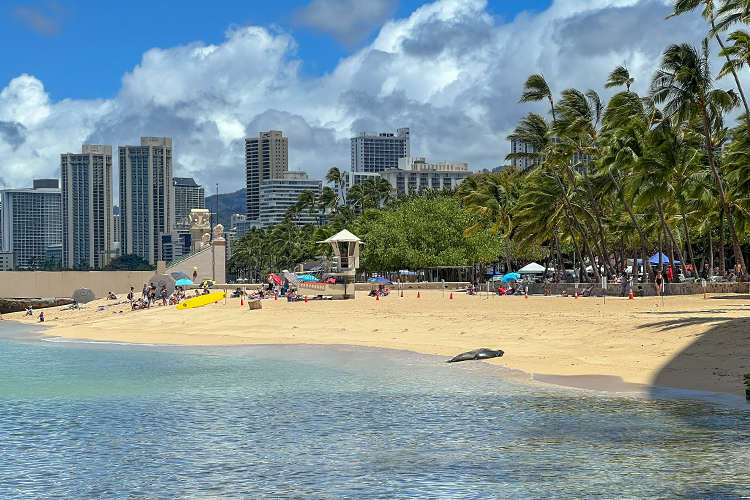Hawaiian monk seal pup Koalani relocated from Waikīkī to new secret home

On the evening of Aug. 18, Hawaiian monk seal pup Koalani was relocated from a popular Waikīkī beach to a remote Oʻahu shoreline where he can grow up wild and in the company of other wild monk seals, not tourists.
Koalani became a bit of a celebrity while his mother Rocky taught him survival skills under the 24-7 protection of officers from the state Division of Conservation and Resources Enforcement and volunteers from Hawai’i Marine Animal Response.
A 50-yard cordon was set up around the seals, with state officers keeping people away from the seals by land and in the water for the past 15 days. Hawaiian monk seals are one of the most endangered marine mammals in the world.

Koalani was born at Kaimana Beach on July 9. He was the 14th pup born to Rocky, who usually gives birth on Kauaʻi, according to NOAA FIsheries.
On July 24, a swimmer encountered the seals in the water near the Natatorium. The protective mother seal bit the swimmer, causing minor injuries. The incident highlighted the real risks facing both the animals and curious humans who intentionally or inadvertently get too close.
That incident led to the unprecedented law enforcement visibility and public education that started on Aug. 3 to protect the seals and people.
Rocky showed signs on Aug. 17 that weaning was imminent for Koalani.
According to NOAA Fisheries, when a mother seal weans her pup, she begins to stop nursing and guiding the pup, ultimately leaving it as a now-independent seal. The pup must learn how to forage and survive on its own. The mother begins to forage for food and restore her energy reserves to begin a new reproductive cycle.
After an extensive risk assessment, NOAA Fisheries said it decided to relocate Koalani, just as it did the pup Lōliʻi from the same beach last year
“Leaving Koalani at Kaimana Beach after weaning carries a set of risks, as does relocating him to any other beach,” according to NOAA Fisheries. “And each time we identify a seal that may need potential intervention, like Koalani, we conduct a careful and thorough risk assessment.”
The NOAA Fisheries team whittled the dozen or so potential beaches down to the top three with the lowest level of risks. They delved deeper into the short- and long-term risks associated with each beach and carefully weighed them against the risks of leaving Koalani at Kaimana Beach.
Habituation is the largest issue with leaving Koalani in place. A young seal that receives positive interactions from people, such as through attention, play or being fed, will continue to seek out humans for these interactions.
The seal may rely on people for interactions, rather than developing the skills it needs to forage for food and interact with other seals in the wild. It may also not learn to avoid marine hazards.
As it grows larger, the seal can become a danger to people. Past habituated seals have blocked people from leaving the water, sometimes grabbing them from behind. A fed seal could also become reliant on people for food, unable to survive in the wild on its own. Or it may become aggressive toward people if it doesn’t receive food from them.
As Koalani grows older, he will expand his range at his new location. He will still have to face many threats, and he will find his preferred spots to forage, haul out and interact with other seals.
“Maybe he will encounter some of his siblings, and maybe he’ll even show up in Waikīkī once in a while,” NOAA Fisheries said in its blog.
The Division of Conservation and Resources Enforcement (DOCARE) estimated it devoted more than 500 man-hours to the 2-week mission to protect Rocky and Koalani, and to educate the public about the endangered species.
“While this duty certainly taxed DOCARE resources to the limit, we felt law enforcement presence was called for to prevent any further encounters, which could well have ended tragically,” said Suzanne Case, Chair of the Department of Land and Natural Resources (DLNR).
With the monk seal population continuing to grow in the main Hawaiian Islands, and moms showing up more frequently to pup and wean their offspring on populated beaches, DLNR is exploring strategies to provide the level of safety and security needed to keep anyone from getting hurt and from the wild animals becoming habituated to people.
“Clearly the presence of our DOCARE officers made a huge difference and were a needed supplement to the great efforts of the volunteers from Hawai’i Marine Animal Response, who were constantly monitoring and moving the physical cordon as Rocky and Koalani became more and more active,” Case said.









